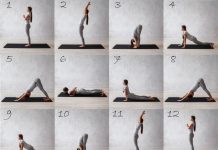Qigong (chee-gong) yoga originates from China and has also been called “Taoist Yoga” or “the Chinese version of yoga” and is a practice that promotes using energy to produce work or progress. Energy can be spiritual energy and devotion to practice or the physical energy that is put into a practice, the best is a homogenization of the two creating an energetic equilibrium.
From its origins in China to its relationship with India and its journey to the United States– Qigong is becoming increasingly popular in both private practice and medical healing. It is an inclusive activity that caters many benefits that reach a wide array of people.
Let’s explore the basics of this interesting and unique practice!
History of Qigong Yoga
Qigong began thousands of years ago in China, similar to yoga in India, and finds its roots deep in Taoist tradition. Taoist philosophy teaches a keen sensitivity to balance; balance between the yin and the yang, feminine and masculine, all to balance and become closer to the Tao. Tao means the “way” the “virtue” or the “path” in Chinese. It makes sense then, to find the way or the path to all that is, you must first find balance within yourself. “Gong,” can mean a job or a skill that is refined with consistent practice. With steady consistency of energy, it will slowly become refined.
How do You do Qigong?
Similar to Yoga, there are various postures performed in Qigong practice. Qigong incorporates meditation and encourages visualization with intense channeling of energy. There is also a strong component of an emphasis on breathing through the diaphragm. Breathing through the diaphragm is also known in practice as “belly breathing,” and promotes stability and good digestion. There is a strong connection to health within Qigong.
Qigong Versus Traditional Yoga from India
Let’s be clear, Qigong is not a traditional yoga practice– Qigong originated in China and Yoga in India. Postures are completed slowly with a conscious fluidity that differs from traditional yoga and is reminiscent of Tai Chi.
The Qigong practice seeks balance of mental and physical energy, but tilts more in the way of mental energy and meditation than traditional yoga. There is an offshoot of Qigong which is martial and has more of a physical element to it—as it is a martial art.
Who Can do Qigong?
Qigong is not so much physically demanding as it is mentally demanding. The main goal of the physical aspect of Qigong is to elongate and strengthen by using subtle movements backed with intention. Anything that is backed with genuine intention will put the energy where it needs to go to be a benefit.
Anyone can practice Qigong by sticking to subtle movements and listening to their bodies; the ability to take time and looks within to hear the cues of the body plays to the mental aspect of Qigong and the meditation element. There is no prime age range or athletic requirement, only the drive to put in the time and energy to see progress.
Modifications can be made to practice Qigong; there are tutorials available to modify and practice while sitting in a chair as well.
The point is not to make you sweat, Qigong is known to be a gentle exercise and a rewarding mental journey.
Qigong as a Healing Tool?
Recently the United States has taken an increased interest in holistic medicine. There have been increases in cupping, acupuncture, natural birthing methods and so forth; this makes it no surprise that the concept of Qigong healing has become increasingly relevant in the United States. Americans have taken to using Qigong to heal some of the following issues: insomnia, back pain, neck pain, anxiety, stress and arthritis.
In China, there are medical professionals who are trained in using energy or “qi” to heal patients while improving their well-being. Doctors are not the only people who can use Qigong as a healing tool; followers of Qigong can practice Spiritual Qigong to meditate and use their energy to improve their inner-self and inner-strength.
Aside from physical health benefits, the mental benefits of having increased ability to focus for long periods of time after becoming strong in meditation practice are incredible. Those who practice meditation report an increased creativity, a reduction in restlessness and overall better emotional mood.
Should You Try Qigong?
Now that you have an idea of the benefits and ease of beginning Qigong practice, go ahead and try it! There are various resources and testimonials available that can teach postures and techniques; in addition to a rising popularity of community classes that teach the practice becoming available. For something that has been around for thousands of years and has such an impact on mental and physical well-being, it would be silly not to give it a try and see the results first hand!
47 Most Famous Motivational Quotes of All-Time
49 Greatest Love Quotes
37 Inspirational Quotes that Will Change Your Life






























